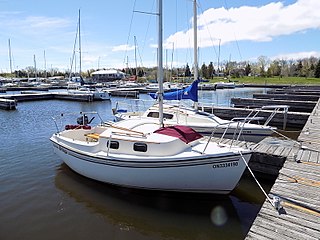
The word Drascombe is a trademark that was first registered by John Watkinson who applied it to a series of sailing boats which he designed and built in the period 1965–79 and sold in the United Kingdom (UK). They comprised the Coaster, Cruiser Longboat, Dabber, Drifter, Driver, Gig, Launch, Longboat, Lugger, Peterboat, Scaffie, Scaith and Skiff, together with a few other one-offs. They have wide and deep cockpits, adaptable boomless rigs and high bulwarks.

The Sandpiper 565 is trailerable sailboat that was designed by the British-based Portuguese naval architect Leonardo da Costa Sayago and first built in 1972. The design is out of production.
The Hartley TS16 is an Australian trailerable sailboat that was designed in 1956 by New Zealander Richard Hartley as a day sailer and which later became a one design racer.

The Sanibel 18 is an American trailerable sailboat, that was designed by Charles Ludwig, first built in 1982 and named for the Floridian town and island.

The Siren 17 is a Canadian trailerable sailboat, that was designed by Hubert Vandestadt as trailer sailer and first built in 1974.

The Buccaneer 200 is an American trailerable sailboat, that was designed by Alan Payne and first built in 1974.

The Paceship 20 is a Canadian sailing dinghy, that was designed by Cuthbertson & Cassian and first built in 1970.

The MacGregor 25 is an American trailerable sailboat that was designed by Roger MacGregor and first built in 1973. From the start of production until 1980, it was sold as the Venture 25.

The Naiad 18 is a Canadian trailerable sailboat, that was designed by Mark Ellis, first built from 1984 to 1986, and named for the mythological water sprites.

The Catalina 18, formerly known as the Capri 18, is a trailerable American sailboat that was designed by Frank Butler and Gerry Douglas and first built in 1985.
The Hunter 18.5 is an American trailerable sailboat that was designed by the Hunter Design Team as a cruising sailboat and first built in 1987.
The Hunter 19-1 is an American trailerable sailboat that was designed as a day sailer and small cruising sailboat by the Hunter Design Team and first built in 1981.
The Hunter 19-2 is an American trailerable sailboat that was designed as a day sailer and small cruising sailboat by the Hunter Design Team and first built in 1993.
The Hunter 19 (Europa) is a British sailboat that was designed by Oliver Lee and first built in 1972.

The Com-Pac Sunday Cat is an American trailerable sailboat that was designed by Clark Mills, who had previously designed the Optimist.
The Dawson 26 is an American trailerable sailboat that was designed by Robert Finch as a cruiser and first built in 1973.

The Skunk 11 is a Canadian utility dinghy that can be rowed, used as a motorboat, fishing boat or as a sailing dinghy. It was designed by Hubert Vandestadt and first built in 1969.
The Drascombe Scaffie, now marketed as the Devon Scaffie, is a British trailerable sailboat that was designed by John L. Watkinson and first built in 1978. The modern Scaffie is based upon a traditional British boat design that dates back several hundred years.
The Typhoon 18 is a family of American trailerable sailboats that was designed by Carl Alberg as day sailers and cruisers, first built in 1967.

The Jeanneau Arcachonnais is a French trailerable sailboat that was designed as a day sailer and pocket cruiser, first built in 1969.














